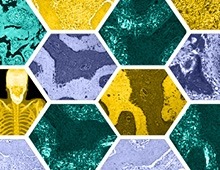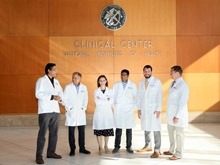Fall 2023
NIDCR News
-
Celebrate 25 Years of Fibrous Dysplasia/McCune-Albright Research — September 11, 2023
Join us for a symposium from 9:00 a.m.–12:30 p.m. on September 11 at NIH to celebrate NIDCR’s 25-year legacy of research to understand and treat fibrous dysplasia/McCune-Albright syndrome. Among the speakers will be Brian Kobilka, M.D., who won the 2012 Nobel Prize in Chemistry for his work on G-protein-coupled receptors. A reception and historical poster session will follow the symposium. For more details, including an agenda and videocast link, visit the symposium webpage.
-
Celebrating NIDCR Trainees: Past, Present, and Future — October 10-11, 2023
Prospective and current NIDCR-supported trainees from all career stages, as well as anyone else who is interested, are invited to attend the NIDCR 75th Anniversary Trainee Symposium: Celebrating NIDCR Trainees: Past, Present, and Future, on Tuesday, October 10 and Wednesday, October 11, 2023. This virtual, free event will offer professional development and networking with peers, NIDCR staff, and leadership, and will feature Nobel laureate Ardem Patapoutian, Ph.D., as the keynote speaker. To register, access the agenda, and more, visit the event page.

NIDCR invites recommendations from the research community on the needs and best practices for dental, oral, and craniofacial data storage, management, infrastructure, sustainability, and tools. The goal is to build and support a data ecosystem that better enables investigators and clinicians to extract insights from datasets to improve oral and overall health. Respond by Monday, September 25, 2023.

NIDCR kicked off its yearlong anniversary celebration with symposia in March and June. On March 17, former NIDCR directors, current leaders, and investigators gathered at the AADOCR 2023 Annual Meeting to reflect on the institute’s accomplishments and scientific advances that have shaped dentistry and medicine. On June 27, leaders from NIH, the scientific community, and professional society and federal partners convened at NIH to highlight NIDCR’s efforts to improve the nation’s oral health and well-being, drive health policy, foster new generations of researchers, and more. For event recordings, photos, and more, visit NIDCR’s 75th anniversary webpage.

On September 1, Deputy Scientific Director Indu Ambudkar, Ph.D., M.Sc., assumed the position of acting scientific director of NIDCR’s Division of Intramural Research (DIR). Matthew Hoffman, B.D.S., Ph.D., who held the position for five years, will continue to serve as a senior investigator in DIR’s Matrix and Morphogenesis Section, where he studies salivary gland development. During his tenure as scientific director, Dr. Hoffman made considerable strides in building a robust and diverse scientific program at NIDCR by hiring many new tenure-track investigators and NIDCR’s first Independent Research Scholar, and by creating associate scientific director positions to provide investigators with leadership and administrative opportunities.

On June 21, NIDCR Director Rena D’Souza, D.D.S., Ph.D., and NIDCR investigators John Chiorini, Ph.D., and Niki Moutsopolous, D.D.S., Ph.D., received International Association for Dental Research Distinguished Scientist Awards, among the highest honors bestowed by the organization. Dr. D’Souza was recognized for her contributions to craniofacial biology research. The award is her second, a rare feat. Drs. Chiorini and Moutsopolous were honored for their research on salivary gland biology and periodontitis, respectively.
Training News

Join NIDCR Training Director Belinda Hauser, Ph.D., and NIDCR Deputy Director Jennifer Webster-Cyriaque, D.D.S, Ph.D., on Tuesday, September 26 from 1:00 p.m.–2:45 p.m. for a webinar about dental, oral, and craniofacial research training opportunities in NIDCR labs on the NIH campus. Attendees will learn how to apply for these opportunities and will hear from a former NIDCR trainee about their experiences. Registration is required. To sign up, visit the registration page.

Are you interested in joining NIDCR as a postdoctoral fellow with up to five years of funding? NIDCR’s Sang-A Park Memorial Intramural Postdoctoral Fellowship is now open until filled. Established in memory of NIDCR postdoc Sang-A Park, Ph.D., the fellowship is designed to foster the career development and mentoring skills of researchers from diverse backgrounds.

Are you a biomedical researcher with student loan debt? You may qualify for the NIH Loan Repayment Program, which repays up to $50,000 of educational debt annually in return for a commitment to engage in NIH-mission-relevant research. NIH is accepting applications from researchers at institutions around the country through Thursday, November 16, 2023. You do not need to receive NIH funding to participate. Visit the Loan Repayment Program website for more details.

A recent analysis of NIH’s efforts to promote the growth and diversity of the next generation of biomedical researchers showed that in 2022, the number of NIH-supported first-time principal investigators increased by 6.3% compared to 2021. Also, more Black early stage investigators received funding in 2022 than in previous years. However, the overall number of Black applicants and awardees remained markedly lower than those of their White and Asian counterparts.

Do you have questions about conducting research involving human subjects? NIH’s Division of Human Subjects Research offers information and guidance on proposing and conducting human subjects studies, including an overview on NIH policy, a decision tool, details on inclusion policies, FAQs about clinical trials and more. NIH has also developed a new resource to assist investigators in resolving common human subjects system warnings and errors.
Science Advances

Little did NIDCR investigator Pamela Robey, Ph.D., know in 1993 that by opening a box full of bone samples collected from patients with a rare disease, she would spark a decades-long quest to understand and treat the condition at NIDCR. Called fibrous dysplasia/McCune-Albright syndrome, the rare disease affects the bones, skin, and endocrine system. For the past 25 years, NIDCR researchers have been untangling the underlying disease processes, testing potential treatments in clinical trials, and delivering hope to patients.

In early 2020, scientists around the globe raced to end the COVID-19 pandemic. Among them were NIDCR-supported researchers who pivoted from their regular work to study SARS-CoV-2 infection processes and invent new testing methods to monitor the spread of the virus. These studies are helping pave the way to better interventions, answers on Long COVID, ways to address COVID-related health disparities, and approaches for readying the world for future pandemics.

What shapes our faces? Six decades’ worth of NIDCR research is helping scientists crack the code of facial appearance and craniofacial conditions such as cleft lip with or without cleft palate. From untangling the genetic and environmental factors underlying craniofacial anomalies to improving surgical interventions and outcomes, scientists are paving the way for tailored prevention, diagnosis, and treatment for dental, oral, and craniofacial disorders.

In an I Am Intramural Blog post, former NIDCR investigator Marian Young, Ph.D., who retired in May, spoke about her research on biglycan, a bone protein she and colleagues discovered in the early 1980s. Recently, Dr. Young’s team revealed that biglycan may help prevent premature bone growth, which can weaken bones during bone development and healing. The findings could lead to new ways to help people with conditions that cause brittle bones and bone loss.

In an NIDCR-supported study, researchers identified a bacterial duo — Selenomonas sputigena (S. sputigena) and Streptococcus mutans (S. mutans) — linked to tooth decay in children. They found that S. sputigena formed a honeycomb-like structure that encases S. mutans to increase and concentrate the production of tooth-damaging acid, which boosted tooth decay in mice. Breaking the relationship between the two bacteria could be a strategy for preventing dental cavities.
Grantee News
NIH/HHS News

The NIH Build UP Trust Challenge is seeking solutions to build trust and improve engagement with historically underserved communities. NIH will award a total of up to $1.25 million. To submit an idea, participants must register by Tuesday, November 14, 2023. All submissions are due Tuesday, December 5, 2023.

To accurately reflect its goal of turning scientific discoveries into better health for all, NIH is seeking suggestions on an update to its current mission statement. The proposed revised mission statement is “To seek fundamental knowledge about the nature and behavior of living systems and to apply that knowledge to optimize health and prevent or reduce illness for all people.” NIH invites the public to submit a response by Friday, November 24, 2023.

Initial findings from an NIH-funded study of 9,764 Americans have revealed new details about Long COVID, the post-infection set of conditions that can last for months or years. The researchers identified common symptoms, including fatigue, brain fog, and loss of smell or taste, and developed a symptom-based scoring system that could improve future diagnostics and treatments. The team also found that Long COVID was more common and severe in study participants infected before the Omicron variant emerged in 2021.

To discover and catalog the breadth of genetic variation in the cells and tissues throughout our bodies, the NIH Common Fund launched the Somatic Mosaicism across Human Tissues (SMaHT) Network. Somatic mosaicism is a type of genetic variation that arises when an organism’s non-reproductive cells differ from each other genetically. This can alter how cells function and may influence human development, disease, and aging. NIH has issued 22 awards totaling $140 million over five years to establish the SMaHT Network.

Researchers have released a new high-quality collection of reference human genome sequences that captures substantially more diversity from different human populations than what was previously available. The new “pangenome” reference includes genome sequences of 47 people, with the researchers pursuing the goal of increasing that number to 350 by mid-2024. The work was led by the international Human Pangenome Reference Consortium, which is supported by the National Human Genome Research Institute.


